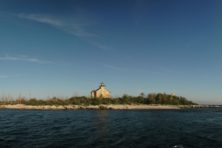Sportsman’s Club Wants to ‘Bring Pilot Island Back to Life’
- Share
- Tweet
- Pin
- Share

The Washington Island Sportsman’s Club is calling on the U.S. Fish and Wildlife Service (FWS) to “bring back Pilot Island for all to enjoy.”
The club sent a response late last month to the FWS’s regional director, Charles W. Traxler, requesting that the FWS address, by June 23, what it called a “clear-cut direction from the public” on how the island could be restored for public use.
The Sportsman’s Club replied to answers the FWS provided earlier this year to Pauline Meyer, a staff member of Rep. Mike Gallagher, whose assistance the club has sought in dealing with issues on Pilot Island. The FWS manages the island as a migratory bird nesting area that’s closed to the public.
A letter that Sportsman’s Club president Martin Andersen sent late last month with the detailed response asked Traxler to reply to the club within the next couple of months to “ensure effective communication. In the past, we have received responses that did not address all of our concerns directly or at all,” Andersen said.
The Sportsman’s Club wants the FWS to restore the 3.5-acre island off the tip of the Door peninsula as it existed decades ago and no longer use it as a colonial sanctuary for cormorants and other migratory birds. The FWS has oversight of the Green Bay National Wildlife Refuge, where Pilot Island is located. The U.S. Coast Guard turned Pilot Island over to the FWS in 2007.
The Sportsman’s Club, which previously characterized Pilot Island as having turned into a “smelly, polluted eyesore,” has asked that the FWS respond by Aug. 25 to concerns or issues the club addressed regarding the answers the federal agency provided in response to Meyer’s questions.
“Our concern is that the putrid smell [from the cormorants’ guano on Pilot Island] may be carrying [airborne] diseases to the public,” the Sportsman’s Club’s response stated. “Specifically, we need to know if there is a potential for histoplasmosis to be carried to our community members.”
FWS figures estimate the island’s cormorant population was around 9,765 in 2021, based on 3,756 nests there during the most recent count, with each nest calculated to represent 2.6 birds.
The Sportsman’s Club claims in its response that the FWS has failed its “due diligence” in assessing the environmental impact caused by having a policy of “unlimited birds on Pilot Island.”
“Pilot Island is clearly no longer a well-balanced environment,” the club’s response stated. “Immediate fisheries are gone; adjacent fisheries [are] severely impacted; the ecosystem is damaged; and the native wildlife and vegetation have been destroyed.”
The Sportsman’s Club reiterated that its expected outcome for Pilot Island includes these actions:
• Remove the cormorants, pelicans and gulls.
• Remove the cormorant guano, and replace it with fertile soil, flora and trees; and return the island to its original state by restoring and maintaining the fisheries, wildlife and environment that once existed.
• Preserve and restore the lighthouse keeper’s building to its original state.
• Reconstruct the fog-signal building to its original state.
• Build a dock and boat channel so visitors can safely access and enjoy the complete experience the island has to offer.
Support for the Sportsman’s Club efforts to change how the FWS is managing Pilot Island were bolstered in February when the Door County Board of Supervisors passed a resolution disapproving of the island’s current use as a colonial bird nesting area.
That resolution called for the restoration of the “local environment, wildlife, fisheries and historical structures, [and] removing the problems on Pilot Island that impact the surrounding Door County communities and its citizens.”
The Town of Washington and the Town of Liberty Grove previously went on record in support of a change in the management of Pilot Island as called for by the Sportsman’s Club, which has also been conducting an online petition drive at savepilotisland.com.
FWS Preparing Response
FWS project leader Bill Peterson – whose role with the federal agency includes overseeing the Green Bay National Wildlife Refuge, where Pilot Island is located, and who has met with Sportsman’s Club members in the past – said the FWS is reviewing the club’s latest response and preparing a response to it.
Peterson said the FWS continues to check on Pilot Island, where a repair on the lighthouse roof is planned this year to replace asphalt shingles, and where nest counts will be conducted in the future.
He said there is currently no sign of the birds on Pilot Island having avian influenza, and although repairing the roof this year is a short-term solution, the long-term fix favored by the FWS calls for installing a metal roof on the lighthouse, which would be more durable but would require approval from the State Historic Preservation Office because of the building’s historic designation.


